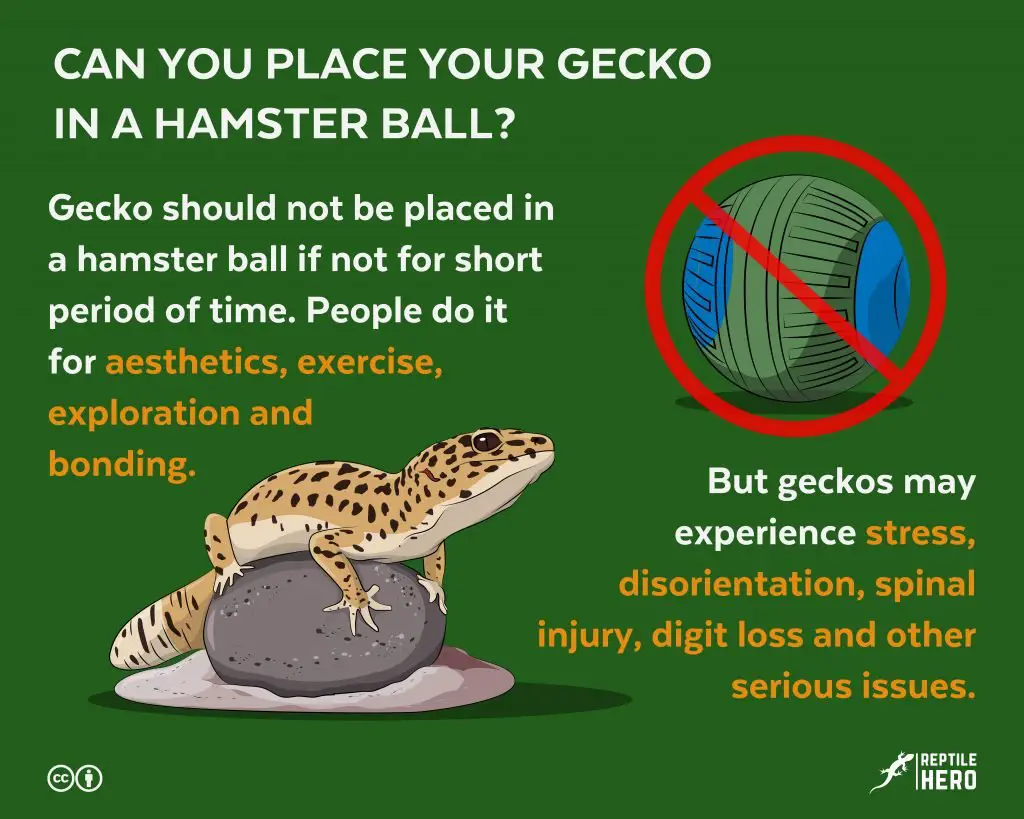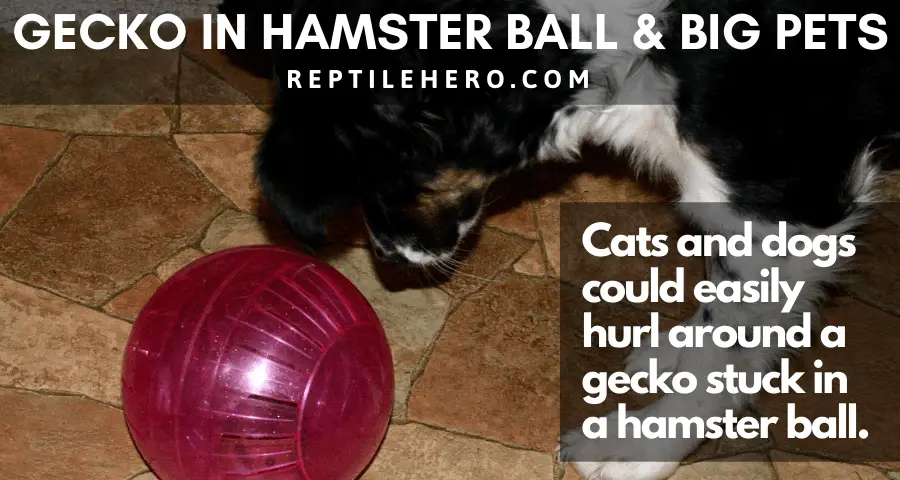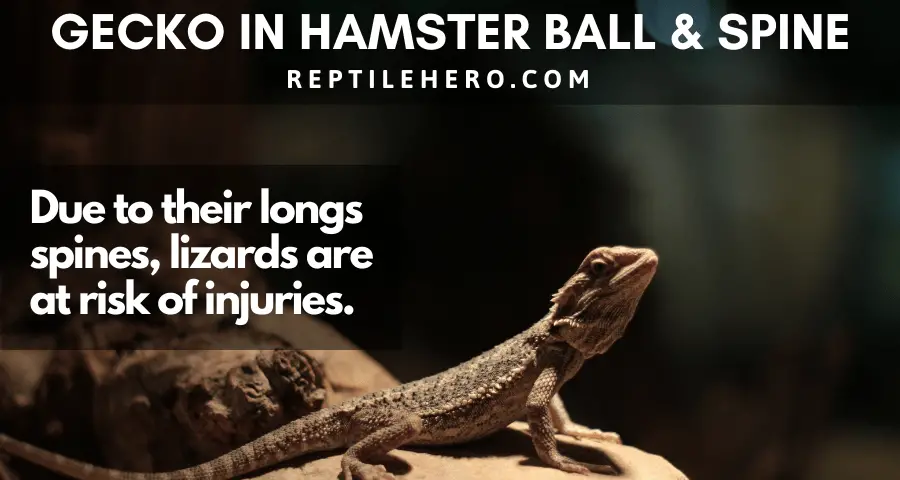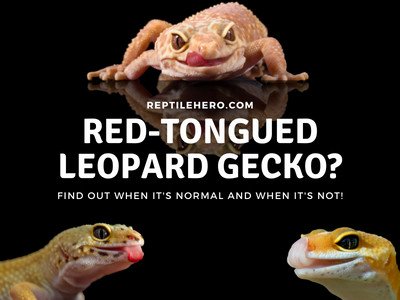Can You Place Your Gecko In A Hamster Ball? [Bad Idea]
Sometimes, I just want to let my gecko out of his enclosure and let him roam around the house but I don’t want to risk losing him or injuring him. But then I came across some forums sharing what they described to be a great solution for my troubles: hamster balls.
Geckos can be placed in clean large hamster balls for a short period of time. People do it for aesthetics, exercise, exploration, bonding. However, it is very likely that geckos may experience stress, disorientation, spinal injury, and digit loss, and other serious issues.
Before placing an order for one online, continue reading as I get into the nitty-gritty of it all.
Geckos In Hamster Balls: Is It A Good Thing Or A Bad Thing?
For the longest time, this has been the topic of arguably heated debates. Some attest to its harmlessness for geckos, saying that they have been doing it for years without any problems for them or their lovely pets. However, so many others cite numerous reasons as to why they voice strong opposition to doing it.
So what exactly do both sides of the argument really have to say?

Why Do People Use Hamster Ball?
This might sound crazy to most gecko hobbyists nowadays, but there was a time when many keepers and breeders actually regularly placed their geckos into hamster balls.
Although many did receive criticism for it, they argue that they would have stopped if they actually saw that it was dangerous for their soft-skinned lizards. They also assert that placing geckos into these plastic globes has many advantages.
Aesthetics
In explaining why they place their reptile friends in plastic exercise balls made for rodents, many simply say that they started doing it because it looked cute. Many made up their minds to try it out after seeing the pictures and videos other enthusiasts have posted online.
Geckos looked like they were inside clear eggshells, trying their best to hatch by rolling around the ground like what we used to see in cartoons as kids. They just found the sight of it absolutely endearing and charming.
Exercise
Some gecko owners lack the funds for incredibly big and enriched reptilian vivarium set-ups. Because of this, their geckos have limited spaces in their small enclosures to exercise.
Then an idea popped into their heads: plastic exercise orbs for pets! If other small pets could use it, why can’t geckos, right? What’s more, is that they are cheap and easy to find in local pet stores.
People have let their geckos run on hamster wheels before so hamster balls probably wouldn’t be that much different. Plus, by using the exercise globes geckos can safely move around larger areas. They loved running on hamster wheels, so they’re sure to love running in hamster balls as well.
Exploration
Usually, letting geckos explore around the house without much supervision could be problematic. These agile lizards could escape through slightly opened doors and windows, get crushed or stepped on, or get stuck in small crevices.
Keepers and breeders alike could let their geckos roam around the house with little to no supervision at all because they were safe inside big hamster balls. Owners could go about their day, doing their chores or work, without having to worry that their squishy cold-blooded babies were in danger.
Of course, they do make sure that their balled-up geckos aren’t near the stairs where they could fall off. Other precautionary measures include setting up carpets around a certain area to set up a boundary and making sure no heavy or sharp objects could fall onto them.
Bonding With Bigger Pets
Others swear that putting their geckos in hamster balls allowed them to safely bond with all the other bigger pets in the house.
If larger pets started becoming aggressive, geckos are still protected by the thick plastic from possible bites and scratches. And you could always just easily pick them up and separate them from the other before things get bad and physical.
Temporary Housing
I remember one keeper sharing her experience with placing her crested gecko in a plastic cup while tidying up its enclosure. After the clean-up, she came back just in time to see that her gecko had tipped the cup over and started rolling around while still inside to keep itself entertained – or so she claims.
She shared it with other keepers and said that it was probably her crestie’s way of telling her it wanted a hamster ball instead of a plastic cup next time.
Although many others condemn this practice, those who do it maintain that it is safe to use on geckos and even bring up the existence of round gecko hides. They contend that if these transparent spheres were truly bad for geckos then hollow coconut shell hides wouldn’t be so popular, especially since they are normally even smaller than plastic exercise balls.
There are even tutorials online that show you how you could make it for your geckos like this one:
9 Reasons Why Using Hamster Ball Is A Really Bad Idea
The few people who do place their geckos in hamster balls claim that it poses little to no harm for their cold-blooded buddies. However, I would still advise against this practice because it could do more harm than good.
The following are counterarguments and other serious concerns experts point out to discourage this practice.
Cute But Not Safe
Yes, geckos do look cute in these synthetic contraptions. However, just because it looks good doesn’t mean it’s actually good.
It’s called a hamster ball and not a gecko ball for a reason. If these things were truly safe and good for gecko enrichment, then manufacturers of pet accessories and toys would’ve long started making them.
Then again, it’s long been known to be harmful even for hamsters and other pet rodents. So even now, most rodent keepers are strongly against using it.
No Intense Exercise
Since geckos in captivity are fed regularly compared to those in the wild, it’s good for them to move around and do some activities to not experience any of the complications that come with overeating.
Even so, they shouldn’t be forced into doing activities that are much too energy-depleting. Reptiles, by their very nature, are terribly prone to tiring themselves out when engaging in strenuous activities such as running around continuously at a very fast pace.
Both hamster wheels and hamster balls force geckos to waste energy on running instead of conserving it for other more important things – like hunting for prey.
Besides, these tools are fairly restrictive and unmanageable. Geckos trying to climb onto the sides or top may suddenly find themselves uncontrollably and dangerously spinning around. And guess what – they probably won’t know how to control or stop it. Imagine yourself in the same situation. Doesn’t sound fun now, does it?
No Cramp Cages
These sticky-toed lizards are innately curious critters. So I do understand why people would’ve thought that letting them go exploring inside hamster balls would be good. And I do recognize the fact that most hobbyists have done it out of good intentions.
However, they won’t be able to truly explore in a small plastic globe that will let them do nothing but scurry around. On the other hand, if they decide to stay still, then they’re going nowhere.
Geckos normally jump about, climb branches and vines, and burrow through substrate among other things. These activities are, of course, impossible to do inside a hamster ball.
Not The “Bonding” Type

It’s quite common for gecko enthusiasts to have numerous other reptiles and amphibians in their care. Snakes, turtles, frogs – name it and they probably have it. Some even have other bigger pets like dogs and cats.
So naturally, many pet owners may want their geckos to get acquainted and bond with the others. Some keepers have tried to do so by introducing their gecko while it’s inside a hamster ball. They argue that it’s a safe way to let them bond with each other.
Unfortunately, even if they are inside a thick plastic sphere, they are still vulnerable. Think about it; dogs like playing with round objects, the same is true for cats. Your big fur babies may try to gnaw at the geckos basically trapped in the ball. They could also try to claw at your lizards. They might even try to bounce or throw it around like some toy, oblivious to the fact that the thing inside is actually alive.
And remember: most reptiles are solitary creatures. You can keep different reptiles but cohabitation isn’t usually advisable unless they are of the same species and are of the opposite sex.
Do Not Use Even Temporarily
Yes, it’s indeed a good idea to temporarily relocate your geckos before cleaning out their tanks. But no, a hamster ball isn’t your best bet for temporary housing.
A better alternative would be a big plastic container for food or storage with ventilation holes soldered into it or a faunarium. If your gecko’s tank only needs a quick clean, say less than 10 minutes, you won’t need to prepare much. If you’re planning to do a deep clean and use the temporary housing for other purposes (carrier to the vet, for quarantining, etc.), you can deck it out and splurge more.
Compared to hamster balls, they are more spacious, stable, and safe.
Now, let’s talk about the coconut shell hide argument with a few simple comparisons.
Do coconut hides and hamster balls even have any similarities at all? Well, there is one thing they have in common: shape. Although the hide is also circular, keepers usually fill the bottom with moss or other substrates so their babies could comfortably lay down inside on a relatively flat surface. Your geckos can also freely enter and leave this type of hide.
Disorientation
Like any other animal, geckos rely heavily on their senses when going about their day – when hunting for prey, avoiding predators, or just exploring their environment. Placing them in hard-to-control, constraining, and brightly colored plastic orbs would limit them from making full use of their senses.
Try to picture yourself in their shoes: you’re trapped in a ball with very little ventilation, the slightest move could have you spinning out of control, and although you can see through the material, your vision is distorted. Not a nice experience, is it?
Stress
Experienced geckos hobbyists would know that simply being relocated to a new environment is already an immensely stressful experience for geckos – regardless of their age or species. So I could only see how much more stressful it would be for them if they were kept in a tight sphere that moved around with a simple lift of a single foot.
I guarantee you, such an experience would stress them physically and mentally. Some breeders have said before that their geckos were completely fine with it but I doubt that. For all they know, the geckos in their care could have actually been trying to escape with no chance of succeeding.
And in their attempts to run away, they could further stress, frustrate, and scare themselves out as they continue to roll about uncontrollably.
I remember even reading one post of a gecko owner advising against this because they have personally tried it out on their cute little baby but was met with a terrible consequence. Their gecko got so spooked and stressed out to the point that it dropped its tail.
Spinal Injury

Sure, spines are naturally flexible – but only to a certain degree. Different animals have developed different spinal structures that move in ways that suit their specific living habits and environments.
Geckos spines are flexible in that they can sleep while all curled up or sway their bodies from side to side when hunting for live insect feeders. But they definitely weren’t made to do anything reminiscent of the cat-cow pose for extended periods.
As a matter of fact, vets say that lizards are especially at risk of injuring their spines due to their length. So if you force your gecko to stay cooped up in a hamster ball for a long time, even if it stays stationary, their spines will have no choice but to bend unnaturally. If the damage is severe, your gecko may suffer from paralysis and waste-excretion problems.
People who have made a regular habit of putting geckos in those plastic exercise balls contend that big hamster balls will not force their spines into unnatural positions. Still, I’d say better safe than sorry.
Digit Loss
If you’ve ever seen a hamster ball before, you’d know that they have small holes or slits on them for ventilation. Now, think about how small and soft gecko limbs and toes are. Do you think they’d make a good combo?
Again, many other experts and experienced enthusiasts have pointed out that there’s a reason why these spherical things aren’t marketed for use on reptiles: it’s not safe. Whether tied onto a heavy thing so it stays still or not, they could easily get their digits and limbs stuck in the air vents.
While trying to free themselves, they could further injure themselves. They could break their bones from applying too much force or they could completely sever a toe or a whole leg. Or they could untangle themselves from this contraption but still end up a mangled mess.
Although some gecko keepers have explained in the past that they would plug the holes or tape them to prevent injury, doing that for your own pets would just cause suffocation.
The Final Verdict On Geckos in Hamster Balls
If you ask me for my final thoughts on putting geckos in hamster balls, I’d say don’t do it. Sure, it sounds good in theory but only in theory.
However, if you need a quick place to temporarily keep your geckos in and have nothing else but a hamster ball in hand, go ahead. But do keep in mind all the dangers I have discussed beforehand and make sure that the ball is either unused or clean and big enough.
You could also place a piece of paper towel at the bottom before letting your gecko in. Place it somewhere safe, where it won’t roll around.
If you do find yourself in a situation where you have no other choice but to do that, I’d suggest that you don’t document it for online posting – even if you think it’s a good idea. That is unless you want to receive lots of negative attention.
Can Hamsters And Geckos Live Together?
Hamsters and geckos are both small, cute, and nocturnal – well, some geckos are diurnal but you know what I mean – so I can let them live and play together, right?
Wrong.
Although both can be incredibly sweet and docile pets, they don’t just suddenly lose their animal instincts once kept in captivity.
Here is a short and simple list of reasons why you should never keep geckos and hamsters in the same enclosure:
- Neither are social animals, they prefer to be left by themselves. Just like geckos, hamsters are highly territorial and are usually not kept even with the same species. If you’re going to keep both, just give them each their own homes.
- Both can be aggressive. Though they don’t necessarily pose a threat to each other, they may steal try to fend each other off by landing the first strike. A hamster on edge can give your gecko a terrible bite. And a gecko will eat pinkies if offered one, these newborn hamsters or other rodents.
- Reptiles and mammals are both possible carriers of salmonella and leptospirosis. If kept together, they are likely to infect each other.
Safer Alternatives For Entertainment
Although highly controversial and frowned upon, the practice of keeping geckos in hamster balls has a single aim: gecko enrichment.
Enrichment is really important for your reptile’s overall wellness, so I want to share safer and better alternatives for you to try out yourself.
Remember, it doesn’t have to be anything complicated or expensive, you can just do, make, or buy simple things that could greatly improve your baby’s quality of life and overall well-being. Science has proven this true.
Leash
This might sound crazy if you’ve never heard of or thought about it before but yeah, geckos can also be leash-trained. If you don’t believe me, just watch this adorable video and I’m sure you’ll want to try it later:
See, it’s possible. You could let them explore inside the house or bask outside with the help of a leash.
Playpen
This may sound like another insane idea but you can set up a playpen for your reptile companion. Different types are available. There’s one made of breathable fabric (as this one on Amazon) and another made of plastic (as this one on Amazon). You could even make one out of old cardboard boxes.
You can make it as simple as possible, with some hides and heating. You can also make it as extravagant as you want, filling it with all the reptile luxuries you could think of.
Feeder Ball
Instead of having your gecko run around in a hamster ball, why not let him run after a small clear ball full of insects (check them on Amazon)? Let him hunt like the insectivore he is.
And guess what – even if you put canned or freeze-dried insects inside, as soon he moves the ball around it will give the illusion of live feeders. Many others have tried it and swear by it.
Takeaways
- You could put a gecko into a clean large hamster ball for a short time. However, I would still advise against it if you have other options;
- Geckos may suffer from stress, disorientation, spinal injury, and digit loss if placed inside hamster balls;
- Good alternatives for gecko enrichment include the use of a leash, playpen, and feeder ball;


![10 Reasons Why Your Gecko Does Not Lay Eggs [with Solutions]](https://www.reptilehero.com/wp-content/uploads/2021/03/Reasons-Why-Gecko-Does-Not-Lay-Egg-Infographic-768x614.jpg)


![Can Leopard Geckos Survive Falls? [2 Real Stories]](https://www.reptilehero.com/wp-content/uploads/2021/07/Gecko-Fall-Infographics-768x614.jpg)
